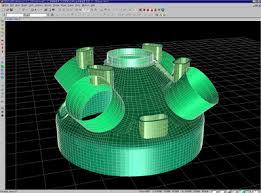
Nature of work
A CAD engineer jobs essentially entail creating technical drawings to be used across a variety of industries that involve the design and production of various tools, equipment, structures, and other products. He/she puts the plans to show the architects and engineers from other areas of specialty how a particular product should be designed and constructed. His/her job essentially combines technical design with process control and artistic skill to produce functional drawings, which are used to build components, perform inspections, obtain competitive price quotes, and maintain document control. Day-to-day responsibilities of a CAD engineer vary depending upon one's current stage in a project. Nonetheless, typical daily duties include producing solid models of parts and ensuing assemblies, generating engineering drawings, specifying materials, geometric alignment, and tolerances, creating mark-ups for new revisions, meeting with vendors, and attending design reviews. He/she often works in teams when developing concepts and brainstorming ideas. He/she also estimates production costs and selecting materials for any given product, and making sure that his/her designs fit all the critical market requirements of the product. Environment of work
A computer-aided design engineer generally works in a clean and comfortable setting. He/she spends most of his/her time at computer terminals, and this may cause health problems like hand and wrist pain, muscle pain, backache, and eyestrain. A worker often needs to visit other departments to interact with drafters, designers, and production personnel. The majority of drafters work roughly 40 hours a week; a small number of them also work part-time.The working environment of a CAD engineer is normally set within an office. A CAD engineer will spend large amounts of time in front of the computer, so he/she may be affected by associated problems such as eye strain and back pain.
Professional life
With experience, a CAD engineer becomes an intermediate engineer and can perform difficult work with minimum supervision. A drafter may promote to high positions like senior designer, or supervisor. A drafter who has a college degree may become an engineer, engineering technicians, or architects. The field of computer-aided design drafting could grow at a slower rate, compared with other fields, within the next decade. The majority of a computer-aided drafter find work in service companies, though employment varies from one place to another depending on the demands of local industries.Range of typical starting salaries: 40000 SYP.
Getting the job
A CAD engineer who has training after high school will get more chances of gaining an entry-level job than those who doesn't. Relevant courses include technical training programs and associated degrees in drafting at technical institutes. Employers look for candidates who not only have skills in mechanical drawing but also have a good knowledge in mathematics, science and engineering technology. A bachelor's degree in any of these areas will increase candidate chances of getting that first drafting job. High school courses in science, mathematics, design, computer technology, and graphics are useful for starting a career in drafting. Employers often prefer those who have completed training at a college, technical institute, or four-year institution. Some technical institutes offer two-year associate’s degree programs. Most public professional-technical institutes require a high school diploma for admission. In order to develop his/her professional life, a CAD engineer should be a member at the Order of Syrian engineers. Skills
A candidate must have special skills that need to be developed to specialize in CAD work.The candidate must be fully comfortable with the interface of the program, he/she is using and its modeling and analysis capabilities. A good understanding of the engineering discipline with which the individual is working is critical, too, since he/she will need to understand, say, the mechanics of an object in order to functionally model it. A person in this role should have good communication skills with a very high attention to details since he/she is responsible for conveying the finest points of a design to necessary parties in a clear and consistent format.
In addition to technical skills, employers tend to look for candidates who have good understanding of physics, science, materials, mathematics, and general principles of engineering. Business skills, awareness of the commercial appeal of any given product, and creativity are also very strong assets in this line of work.
Sources and references
If you need any further information on what is included in this file, you can visit the following websites:- www.cadforum.cz, free tips & tricks, blocks and discussion to CAD
- www.cadtutor.net, CADTutor provides free video tutorials, articles, downloads and a busy community forum for users of AutoCAD and associated software.
- The Order of Syrian engineers, Damascus, Tel: 6627256
- www.arab-eng.org, Arab Engineers Forum.
- Arab Standard Classification of Occupations, 2008, Ed. Arab Labor Organization.
Summary
As a CAD or a computer-aided design technician, he/she will use software to create design plans for buildings and machineries.He/she could work in a wide range of industries from engineering and construction to manufacturing. He/she could work in 2D design, which is known as surface modeling, or 3D design - called solid modeling.
Initially, he/she will use surface modeling to draw a flat representation of the product, for example a new car design.
